Ellen and Jim Have a Blog, Too
We are two part-time academics. Ellen teaches in the English department and Jim in the IT program at George Mason University.


"Afterward:" an instance of how film must differ from text · 7 December 07
Dear Harriet,
As I wrote, this past Sunday I read Edith Wharton’s ghost story, “Afterward”, and then watched another in the Shades of Darkness series of female gothic & ghost story films, the 1983 “Afterward” (screenplay Alfred Shaughnessy, director Simon Langton, producer June Wyndham-Davies). The comparison of these two brought home to me how ineluctably different a film must be from a text no matter how faithful the film-makers wanted to be.
What came out strongly in the film was the role of the house: this ancient house is connected to the past and hidden time and thus to some metaphysical realm where deep hurts are not forgotten and are revenged, even if the irretrievable act (including deaths) occurred thousands of miles away. The film suggests that to want to connect to an old country and to deep past of landscape shows a dangerous innocence.
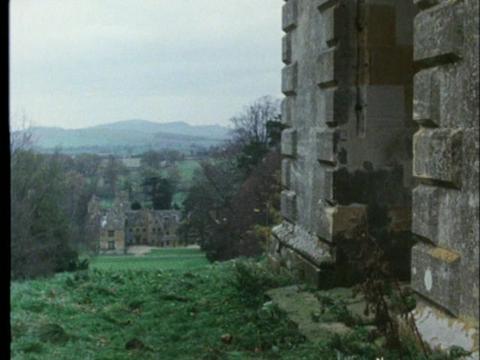
Mary Boyne (Kate Harper) and Ned Boyne (Michael Shannon) just out of sight, gone into the ancient temple (Afterward) (Granada 1983)
From Wharton’s text:
“The life had probably not been of the most vivid order: for long periods, no doubt, it had fallen as noiselessly into the past as the quiet drizzle of autumn fell, hour after hour, into the fish pond between the yews; but these backwaters of existence sometimes breed, in their sluggish depths, strange acuities of emotion, and Mary Boyne had felt from the first the mysterious air of intenser memories.”
The difference and this new emphasis comes out early in the film, in that moment where the viewer first crosses the realm from the realistic into the uncanny: as Mary Boyne, the heroine is told in the story, the viewer doesn’t realize quite that’s what’s happening until afterward or as the film’s movement into the uncanny begins to sink in. In a series of scenes totally unsupported by the text, Mary Boyne (Kate Harper) finds a hidden door in the back of an unused room. She opens it, walks up a long unused stair-well:
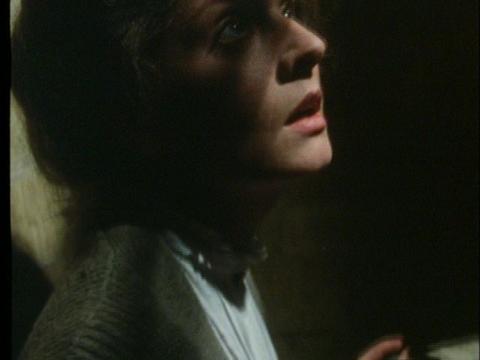
Mary Boyne (Kate Harper)
Then stands for a moment in the attic, bemused:
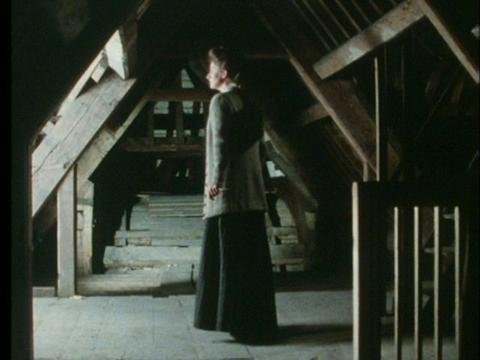
and finally forces open a door that leads onto the roof. Hesitant, somehow anxious, she does not climb up but stands at the threshold:
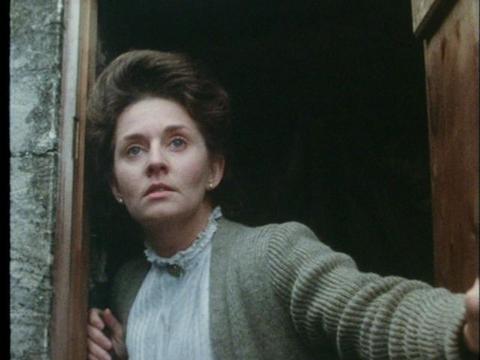
It’s the expression in her face, its whitening feel that registers something out of the way, un-home-y. She calls to her husband, Edward or Ned Boyne (Michael Shannon) to come up with her; he does, reluctantly, but then they walk on the parapet, allured by the ancient village landscape:
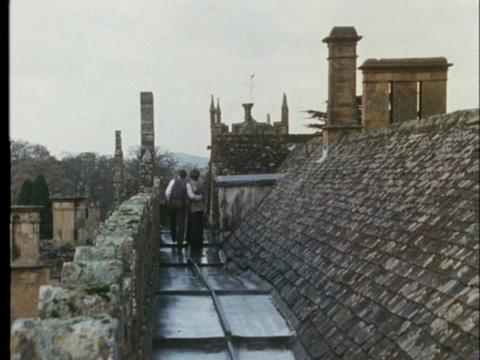
Mary Boyne & Ned Boyne (Michael Shannon) entranced
and it’s there that they for the first time see the ghost. Here they are the moment before:
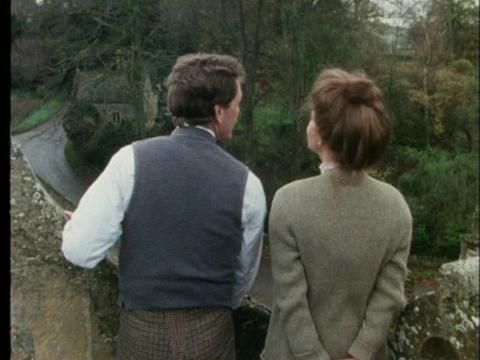
The film can’t help but show the movement into gothic in this visual way and thus shift away from the story’s emphasis on Mary’s gradually awakening moral sense: she has lived off her husband’s unethically obtained earnings all these years, and never looked to see who he hurt and whose loss & grief she therefore was living off of, never faced how cut off she has been from social life and dependent on him.
Both story and film contain alluring suggestive description and a love of English landscape: Wharton’s lines about how many different changes of feels of different places & milieus seem to be nested in small areas in England (“so few miles made a distance, and so short a distance a difference” are repeated and changed in the film as the couple stand by a window gazing out (again at the same square of landscape and so how therefore it’s impossible to get lost.
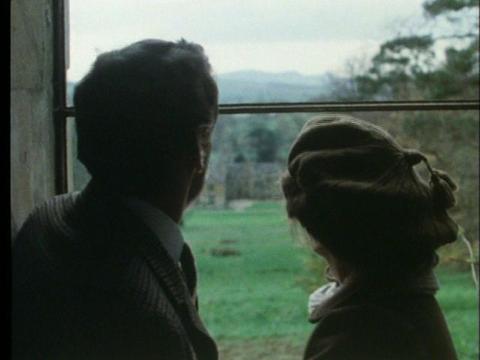
In context, this scene and Wharton’s phrase, now altered, become deadly ironic: for the film’s Edward is found with ease by the ghost, and is then lost forever to Mary.
The social criticism (also in the film if not dramatically pivotal) is in line with what I’ve found in her other fiction (say The Custom of the Country), capitalism’s lack of morality and harshness. The source of the story’s power is that of Ozone’s Sous la Sable: this man was the her “circle of one cherished presence,” what made this woman’s life meaningful, connected, and now he’s vanished. It’s a dependent vulnerable married woman’s nightmare. The last still is of her sitting all alone, forever waiting for him to return, frozen with the knowledge he won’t—though one could take it he’s there now, as a ghost.
An interesting aspect of this whole series (Shades of Darkness) is captured in the icon stills of June Brown as the ghost, Emma Saxton (Lady’s Maid’s Bell):
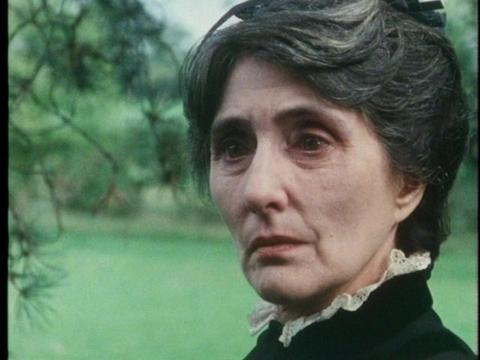
Not only are there close-ups of the ghosts (not in Afterward—that’s more typical), but when we come close-up instead of terror and horror, we feel a common humanity. The face may be ghastly (it’s supposed to be of a revenant, that is a dead person come back), but as in June Brown’s as Emma Saxton (the icon of the series), it is filled with intense wounded emotional pain seeking understanding and help.
In the above still the lighting is that of open day; this is not eerie
night, no owls, no creepy things, fogs. There was a Dracula made in the 1960s (it was praised at the time) where all this sort of conventional paraphernalia was dropped, and the viewer is allowed to enter (& encouraged to acknowledge) the heart of these ghost-gothic fables (human vulnerability) without obfuscating trivializations.
One joke: in Afterward the actors did not quite act their parts naturally. I think they were English people doing American accents terrifically well and that took effort. Nowadays the producer would hire a star in the middle and for such a story, three Americans. But then the actors chosen were those who were trained and good actors with reputations from theatre and plays on TV and radio and who looked the part. So English actors were chosen. The give-away was when they ate: both picked up their fork with the left hand and knife with the right. American first cut their food with a knife with the right hand and then pick up their fork with the right.
Sylvia
--
Posted by: Ellen
* * *
Comment
- P.S. On “Lady’s Maid’s Bell” to which I linked this letter on “Afterward:”
http://server4.moody.cx/index.php?id=750
I reread Wharton’s story once more and also resaw the film—this time on a DVD where the quality of the film and sound and just about everything was vastly improved.
What more could there be to notice: This time about the story, I noticed how the tone and language and grammar of the first person narrative was intended to be lower middle class even if educated and genteel. I noticed also how the story takes place in America and by the Hudson river valley. The film has the story take place in Yorkshire and uses the tradition of gothic in Yorkshire stories.
Now from the film I’m thinking we are perhaps to feel Mrs Brympton was about to elope with Mr Ranford, and Emma Saxton, the ghost, rang Miss Hartley’s bell to stop this affair. So Emma was jealous or didn’t approve. The note Miss Hartley took to Mr Ranford was to keep him away for the week the husband was home, and Mr Ranford knows about the ghost (why he isn’t startled by Miss Hartley’s coming to him) because she’s been haunting him. So maybe the point is not the ambiguity alone.
If this is so, then the ex-lady’s maid is not so much Mrs Bympton’s friend as someone who also became her possessor.
Then all the usual gothic motifs: can’t be a gothic without the heroine wandering up and down stairs in her nightgown with a shawl wrapped around her shoulders. Preferably she should be carrying a candle. I did find myself unnerved by that bell.
I did love the quality of the DVD .The colors were so much more effective. Joanna David’s performance was perfect, and so too June Brown as the ghost. I note June Brown became the icon for the series. The quietude of the film is a quiet pleasure. So many films are overproduced.
E.M.
— Elinor Dec 8, 11:52pm # - Among the elements that makes Shades of Darkness different from the common gothic, is not only are there close-ups of the ghosts (not in Afterward—that’s more typical), but when we come close-up instead of terror and horror, we feel a common humanity. The face may be ghastly (it’s supposed to be of a revenant, that is a dead person come back), but as in June Brown’s as Emma Saxton (the icon of the series), it is filled with intense wounded emotional pain seeking understanding and help:
http://groups.yahoo.com/group/WomenwritersThroughTheAges/
As I wrote, Emma’s motives are left ambiguous (it may be she is attempting to stop her friend, Mrs Brympton from eloping with Mr Ranford), but the originating force of the story is Mr Blympton’s cruelty and Mrs Blympton’s isolation and powerlessness. And that’s engraved on Brown’s face.
Note too how the lighting is that of open day; this is not eerie night, no owls, no creepy things, fogs. There was a Dracula made in the 1960s (it was praised at the time) where all this sort of conventional paraphernalia was dropped, and the viewer was allowed to enter the heart of the fable without obfuscating trivia.
E.M.
— Elinor Dec 10, 6:23am # - From RJ:
“Dear Ellen,
How your post about Afterward makes me wish that I had a copy of the story right here! I want to read it, see the adaptation, and go back over your essay. Thanks so much for the prod.
If I were to set about ordering a collection of Wharton’s stories, though — the Library of America, probably, if I knew which volume I wanted — by the time it arrived I’d have moved on to other enthusiasms. That’s why I wish I had it on hand right now, and that’s why I have so many books that I don’t look at from one end of the year to the other. You never know. It makes more sense, really, to keep books of stories than novels, because it’s more likely that I’ll drop into one or another just in passing; picking up a novel is A Commitment.
It’s totally pathetic of me, but I find that I’m just beginning to know how to organize my reading. On the very eve of sixty! Perhaps it is isn’t necessary to organize one’s reading any sooner — or perhaps one is deluded by the sense of having all the time in the world. In any case, I am keenly aware that I can no longer put books off indefinitely and get to them when the spirit moves me. The spirit is too old to move on its own! I have been having a nice success with a plan of morning reading whereby an hour is devoted to marching through six books: one story from The Decameron, a hundred lines of The Aeneid, two poems by C K Williams (whom I’d never heard of until I bought his translation of The Bacchantes a few years ago), an essay by Clive James, a chapter of Le rouge et le noir, and a handful of letters from the new Mitford collection (the sisters writing to one another).
But this morning stint is often the only reading that I do all day, at least so far as books are concerned. The rest goes to the Times, to magazines, to the New York Review, and of course to the Internet. I am also writing a good deal of the time, and while I’m happy with my output, by and large, I’m appalled by the time that it steals from my reading other people’s things. It seems quite grotesquely egotistical to scribble away for hours all unaware of what others are scribbling! You, in contrast, make time for your generosity.
I do hope that this feeling that I’m a newly-minted adult on the inside, with, for the first time, a clear and distinct idea of what to do with myself, will come to terms soon with the outward facts. If you have any suggestions, I’ll be grateful to hear them!
Best regards,
rjk”
— Elinor Dec 11, 10:12am # - Dear RJ,
What a beautiful letter. How precious is our friendship. I don’t send you and Kathleen an xmas card; think of me as every few days sending a missive :).
I find that I read less too, much less. But it’s not so much the Internet (which has in various ways made me change from constant reader to constant writer) as the very thing that gives me an organization. My projects: two years ago it was postcolonial literature and Trollope and travel books; last year women’s memoirs. The first case was an invite to write learned paper; I never wrote it but what a year I had. the second I delivered two papers to conferences. For the past year I have been studying movies, and how arduous and time-consuming this is. By the time the evening comes I am too tired to read books, for I’ve been reading movies all day. This began with an invite to contribute a paper, and has now developed into a book proposal I sent to Continuum; though they don't seem all that enthused I carry on.
And then there’s social life with Caroline, Yvette, and Edward. All day yesterday I really did that. Gym, a recent movie in a cinema, talk, eat.
I just spend a week on Clarissa, the movie, and hope to write on that too. I’ve too much to write on :). I stick with lists because they help me organize my reading and give me a motive to talk about what I’ve read.
I have told myself there will be books I’ll never read and that’s all there is to it. I read The Aeneid because I taught it whole twice; ditto for Chretien de Troyes’s romances. Funny how reading is a solitary activity, and yet through my access to social worlds (including teaching), I’ve been led to read more great books than I would have on my own. I don’t teach literature any more but then I do, a little on lists.
I wish I could have had your responses to my postings on the movie, Clarissa, but again as reading is an idiosyncratic activity, so too serious movie watching so to speak. So you might have to know Clary, the 2 million word novel as well as have at least some distinct memories of Clary, the movie to respond.
I do so much appreciate your blog. I should say Jim has not set up my computer so I can watch UTube things with ease, so I tend not to open them. They are constantly interrupted as a I watch. I must go off now and study the 1979 P&P some more because at 11:45 I must go to GMU to meet a student at 12:45; I proctor an exam at 1:20. It’s so hard to find time to read RJ, I listen in my car—right now for the umpteeth time yet it still is interesting, Can You Forgive Her?. Maybe my Xmas present from Isabel will be a complete recording of a reading of Thackeray’s Henry Esmond. When else will I find time to read it?
And now I’ve taken up a bit of your precious time but then we are sharing our lives,
Ellen
— Elinor Dec 11, 10:24am # - From RJ:
“Dear Ellen,
Thanks for your kind words about the DB. Thanks for letting me know that your film-adaptation inquiry is not just for the blog. It sounds important. Books can’t as a rule be made into film without serious, almost gagging changes — which is all right once you get used to it — but every now and then there’s an astonishing exception, such as the Coen Brothers’ Mr and Mrs Bridge, which although it fiddles with the “ending” (Evan Connell wrote two books, not one) a good deal of it is absolutely literal translation, turning the book into a virtual screenplay. It’s an exception that proves the rule; Connell’s extremely deadpan style precludes the narrative commentator implicit in most fiction.
While I can’t say that I prefer to go to movies alone, I certainly like to do so. I should rather go alone than see a film I wasn’t very interested in — going along to keep someone company isn’t something that I would readily do. When I do go alone, I am much more open to the terror of not knowing what will happen next. This is a nuisance, really, that I like to get out of the way; for I don’t believe that one sees a movie until the second time. I hate suspense — I hate all forms of not knowing, at least if I’m aware of them — and will often begin with the end of a book just to know who’s still alive on the last page. I was talking the other day about reading Miss Marple mysteries that are anything but mysteries to me now that I’ve watched the Joan Hickson adaptations dozens of times (I do not exaggerate). What a pleasure not to be distracted by clues! I can enjoy Christie’s deft, often witty writing and her roast-beef casts of characters. Her England is a jolly neverland in which everyone speaks English well, even the illiterate.
I hope that you will be having a good holiday season. I have decided to brave it this year instead of trying to duck it. We shall have a small dinner on Christmas day and a tea-party (more or less!) on the following Sunday afternoon. And a tree. How I am to see to all of this while chugging away at the sites is absolutely beyond me, but, as they say, “ask a busy man…”
I hope that Jim will make it easier for you to listen to the podcasts (which have no video element), because I’d appreciate your input. I am more concerned with the technical side of things at the moment, and keen to get better equipment. Only when I have all of that squared away will I really examine what it is that I’m recording. I’d like to be more spontaneous-sounding, but I know from radio experience that nothing requires more preparation, and I’m leery of making a commitment that I can’t keep up. Making the recordings as it is can be onerous. Time-consuming, anyway.
Time for the Times! A good day to you!
rjk”
— Elinor Dec 13, 10:33pm # - Dear RJ,
Do you realize you are reading movies as if they were books?
Me too.
I’ve a friend online who appreciates Christie the way you do and I’ll send on to him your words.
We’ll be home for Xmas too—and with our daughters. We’ve planned to see Sweeney Todd and go out to a nice Chinese restaurant. We’ll go to the MLA meeting in Chicago too. We enjoyed ourselves last year at the MLA in Philadelphia.
A good evening to you, RJ,
Ellen
— Elinor Dec 13, 10:35pm # - from Judy:
"Slipping behind the schedule, I’ve just watched the ‘Shades of
Darkness’ adaptation of Edith Wharton’s ‘Afterward’, and also reread the story, along with the old postings on Ellen’s blog from our previous discussion of this tale on Trollope-l a few years ago. Here are a few more thoughts, which do include plot points.
****
One thing that struck me which we didn’t mention last time round was the title of the book Ned is writing, ‘The Economic Basis of Culture’. This seems to be partly a black joke by Wharton, pointing to the economic basis of Ned and Mary’s adoption of English culture, in the form of the beautiful old house – ie, the dodgy share-dealing which left his partner destitute.
I also think the fact that Elwood has no real hope of legal redress shows that, as Ellen pointed out in the previous discussion, Wharton is here pointing to normal business dealings rather than anything extraordinary and criminal. What Ned did was legal, but it still led to a man’s death and a family’s destruction.
In the film version, I feel the house seems to dominate more than it does in Wharton’s, and I also think it seems more isolated and fragile – maybe not as luxurious as I’d imagined it. There is the feeling it would take a lot of money to keep this house in good order – that there would always be another expense, like the rusted water pipes which need repairing and distract Mary at the crucial moment when the ghost arrives.
I also thought in the film the question of exactly where Ned is now looms even larger than in Wharton’s story. Perhaps this is because of the physical presence of the actor – the fact that he is such a important figure in the first half of the film, brooding and looking worried and dominating his wife’s thoughts, but then suddenly he is gone. It adds an extra strangeness to the story that Wharton leaves us guessing where he is – whether he has wandered away into some other realm with the ghostly figure, or whether he has gone mad or died. I kept expecting his body to turn up in the grounds of the house, which would be a more conventional ending – but there’s no such closure here.
In the first ‘Shades of Darkness’ adaptation, ‘The Lady’s Maid’s Bell’, the ghost is just seen, standing and staring. Here, the ghost actually speaks and looks just like an ordinary person – but I think the film does re-create the chill of the story, in realising only “afterward” that he must have been a ghost.
All the best,
Judy”
— Elinor Dec 27, 1:04am # - Judy writes:
“I also thought in the film the question of exactly where Ned is now looms even larger than in Wharton’s story. Perhaps this is because of the physical presence of the actor – the fact that he is such a important figure in the first half of the film, brooding and looking worried and dominating his wife’s thoughts, but then suddenly he is gone. It adds an extra strangeness to the story that Wharton leaves us guessing where he is – whether he has wandered away into some other realm with the ghostly figure, or whether he has gone mad or died. I kept expecting his body to turn up in the grounds of the house, which would be a more conventional ending – but there’s no such closure here.”
This is a good and new point. Yes—and in the closing scene when she is sitting in the chair and we watch her, there is a sense of brooding terror. Could he be close by? As a ghost? I agree that we saw him as an actor makes this difference and that we see her too. And the house because it must be realized in its specificity suddenly looms as an actor in the story.
A lovely film—beautiful—, no?
E.M.
— Elinor Dec 27, 1:05am #
commenting closed for this article
